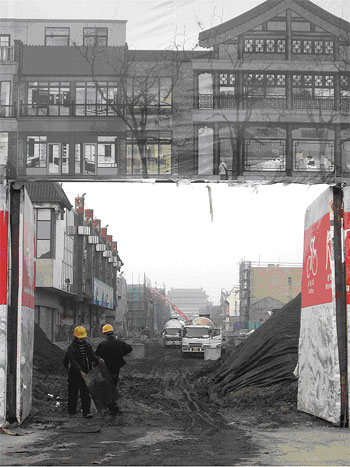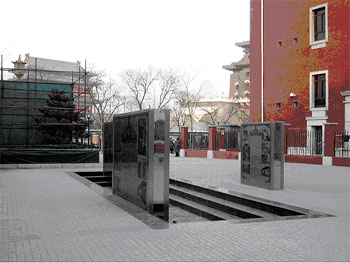|
|||||||||
|
ARTICLESQianmen, Gateway to a Beijing HeritageKelly LaytonThe symbolic and commercial value of the area to the south of Beijing's Inner City was recognised as early as 1550. For it was then that, mindful of the constant threat of raids by the northern Mongol armies, officials from the late-Ming dynasty ordered the construction of a new fortification, the Outer City, that would connect to and extend the southern limits of the original walled region. Comprised of imposing ramparts, and interrupted along its length by seven additional towers and gates, this newly fortified space would increase the walled area of the city by more than half again. Not just protecting the imperial ritual spaces of Ming and Qing Beijing, the imposing Altar of Heaven (Tian Tan) and the Altar of the First Farmer (Xiangnong Tan), the construction of the walls also ensured an easier existence for residents of that area directly to the south of Zhengyang Gate, often referred to as Qianmen or 'Front Gate' (both Zhengyang Gate and the arrow tower to its south were part of a crenellated enceinte long since demolished), an area that would eventually become of equal importance to daily life in the capital as the conspicuous imperial altars were to the prescriptive rituals of empire. Whereas the Inner City, characterised by its Manchu bannerman-controlled districts, princely mansions, intimate vistas, sequestered pleasances and tranquil lanes, defined the more subdued and stately aspects of life in Qing Dynasty Beijing, the area of Qianmen was congested and lively, and encompassed a myriad of residents; laborers and craftsmen, merchants and peasants, scholars and thieves. In 1648, when China's new Manchu rulers designated the Inner City of Beijing as the place for the residences of the Manchu bannermen (the members of military groups organised under various banners composed of those either of Manchu descent or of those who had aided or early on pledged allegiance to the Manchu conquest and the establishment of the Qing dynasty) a new level of complexity was added to the area which had since the Ming dynasty already developed into one of the central commercial areas of the city. The previously privileged occupants of the Inner City during the Ming dynasty were thus forced to move elsewhere, often to new residences in the Outer City. As a result of this brief southern migration Qianmen flourished, as erstwhile residents of the Inner City relocated their roots and businesses to the south. In addition to its already existing reputation as a mercantile centre of shops and provincial guild halls, the area thus also soon became a new entertainment district in which residents and visitors, many of them scholars from other provinces who were in Beijing to sit the civil service examination, could dine out at the many restaurants that lined the streets, find lodgings, purchase luxurious goods, or attend a performance of the opera.[1]  Fig.1 The demolition of buildings in Qianmen district in January 2007. [Kelly Layton]
Fig.1 The demolition of buildings in Qianmen district in January 2007. [Kelly Layton]
Equally important for social life, and for its status as Beijing's entertainment district, were Qianmen's brothels, which catered to the varied sexual appetites of their male clientele. Indeed, according to the local historian Zhang Jinqi (and many salacious accounts in 'apocryphal histories', yeshi), it was here that the Tongzhi Emperor (r.1862-74), during one of his late night incognito excursions to escape from the vexation of court life and his sexually frustrated eunuch retainers, contracted syphilis whilst fulfilling his own concupiscent urges, from which he would eventually die.[2] The presumably 'iniquitous' commerce of the area was not just limited to prostitution, however. The Yongzheng Emperor's (r.1722-35) edict to ban the use of opium in the area in 1729 illustrates the ubiquity of the drug in the city at the time. The drug was smoked in the confines of opium parlours in Beijing, both illustrious and penurious, until the middle of the twentieth century. Similarly, prostitution formed a large part of the commerce of the area in various degrees until the big clean up (da saochu) of both the physical and 'moral' dimensions of what was then Beiping in 1949, when 224 brothels were shut down in the space of twelve hours,[3] although there are many times that number operating in Beijing today. The experience and fortunes of the area have always been intimately connected with the broader history of the city. One of the most significant periods for this area occurred in June 1900, when vast numbers of buildings were burned to the ground at the hands of members of the Boxer Uprising and their foreign enemy. A period of perhaps more significance, however, occurred more recently, and it is here that our story becomes not one of the history of commerce, but of the commerce of history. In 2005, large parts of Qianmen, now one of twenty-five neighbourhoods designated by the government as historic and cultural areas of protection, were razed. The initial obliteration of the commercial street Dashila'r, which was an important conduit for the flows of history in Qianmen, began in 2005.(Fig.1)[4] By late 2006 much of the street was bulldozed, with the brick rubble and debris left behind covered by a pictorial facade and graphics suggesting the new future of the area. More recently the (for Beijing) ubiquitous, and ominous, blue-metal fencing appeared around the main street of Qianmen, and cranes and trucks moved in. After a failed start by another company, the rights to redevelop the area were given to SOHO China, a real-estate development company that has designed and constructed several contemporary, 'avant-garde' developments that make up a large part of the new commercial zones of Beijing. Established in 1995, SOHO China was listed on the Hong Kong Stock Exchange on 8 October 2007.  Fig.2 The main road of Qianmen, now a construction site, with the archery tower in the distance, in October 2007. [Kelly Layton]
Fig.2 The main road of Qianmen, now a construction site, with the archery tower in the distance, in October 2007. [Kelly Layton]
In contemporary Qianmen, computer-generated models, produced in SOHO's offices, are slowly displacing the present architectonic reality of the place. By virtue of the real work of labour, in this Beijing heritage neighbourhood the virtual simulation of space is fast becoming the new face of the real. Once again, the waste and rubble of the present, bespeaking a scene of destruction, has been covered up by gargantuan, ostentatious screens, comprised of computer-generated graphics, which suggest and impose SOHO's vision for the future appearance of the area.(Fig.2) As the physical body of history is removed and displaced, the area has become increasingly historicised. This is part of a broader dynamic in the city as the government paradoxically seeks to emphasize Beijing's cultural heritage in time for the 2008 Olympic Games, and as private industry sees the value in presenting a cleaned up, consumable version of history to property prices. The paradox is that as a result of this positivistic approach -- one that represents a radical reversal of previous revolutionary negations of the past -- more damage has been done in recent years than during the Cultural Revolution. When it is finally unveiled before the beginning of the Olympics in 2008, SOHO's redevelopment of the area of Qianmen promises to be a new, faux-Qing-style pedestrian shopping mall, a heritage site cast in the mould of the old antiquarian street of Liulichang outside Xuanwumen, which was demolished and rebuilt in the early 1980s. As much of its built environment is destroyed, the past of Qianmen will thus again reappear as the rehabilitated spectacle of a themed shopping mall, which completes the state vision for Beijing, that of a modern city with a past. The emphasis on history and the historic nature of parts of Beijing has thus paradoxically augured the destruction and removal of much of its built heritage.  Fig.3 Historical signage: new panels telling a new story of Qianmen, in January 2007. The archery tower of Qianmen is visible on the right, and Zhengyangmen on the left. [Kelly Layton]
Fig.3 Historical signage: new panels telling a new story of Qianmen, in January 2007. The archery tower of Qianmen is visible on the right, and Zhengyangmen on the left. [Kelly Layton]
In addition to the reconstruction described above, signs and panels, outlining the historical significance of the area, were recently installed at various places around Qianmen, as they have in other historic parts of Beijing.(Fig.3) This historical signage imbricates a new civic disposition that precipitates the thoughtful, leisurely consumption of history, and tacitly suggests 'proper' ways of thinking about and experiencing the area. The signs at Qianmen outline what are considered historically significant details, freezing its understanding to a moment in late-Qing history, with no mention some of the more sordid, complex and enlivening aspects of that era, nor indeed of the more recent social and historical vicissitudes of the socialist capital that have occurred since 1949, such as the housing policies of the 1950s, which are of equal importance. The recent Olympic reformation of contemporary Beijing as a modern capital with a past (as opposed to conflicting, unsettled and unsettling pasts) has brought historic areas such as Qianmen into an uneasy relationship with the strangely historicising forces of commerce and capital, as well as with the more subtly operating complexities of Beijing heritage policy. In Qianmen, as physical history is itself obliterated, what is emerging in its place is an image of history. For those who have the time and means to consider the palimpsest of Beijing's past, however, the Front Gate depicts a disturbing history in the present. Notes:[1] Susan Naquin, Peking: Temples and City Life, 1400-1900, Berkeley: University of California Press, 2000, p.411. [2] Zhang Jinqi, The Worldly History of the Eight Big Hutong (Ba Da Hutong li de chenyuan jiushi), Jiaozhou: Jiaozhou daxue chubanshe, 2005, p.80. [3] 'A summation of how the prostitutes of Beijing were dealt with' (Beijing shi chuli jin? gongzuo zongjie) in Beijing Municipal Archives, ed., Beiping at the time of Peaceful Liberation (Beijing heping jiefang qianhou), Beijing: Beijing chubanshe, 1998, p.410. [4] The Da Zha Lan Project, which brings together the work of several artists, photographers and cinematographers, has documented significant parts of this demolition. See http://www.dazhalan-project.org. Dazhalan is the Mandarin pronunciation of dashila'r, as it is called in the Beijing dialect. |